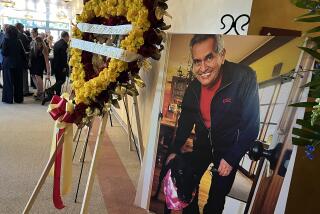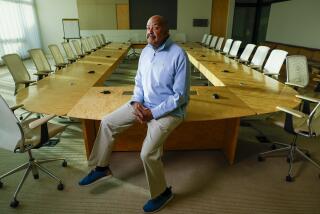Andrea L. Rich dies at 71; former UCLA administrator and LACMA head
Andrea L. Rich, a dynamic, public-spirited leader who rose to the heights of academic administration at UCLA before making a controversial shift to the art world, as head of the Los Angeles County Museum of Art, has died. She was 71.
Rich, who devoted her retirement to the trusteeship of charitable, governmental and corporate organizations, died Monday night at the Ronald Reagan UCLA Medical Center. She had been undergoing treatment for acute myeloid leukemia, according to her son, Robert Rich. Although she had been in poor health for several years, the fatal disease came on suddenly and progressed quickly, he said.
In an interview a few months before Rich’s death — at her home in Ojai where she established a working vineyard and provided an educational environment for artistically inclined, disadvantaged youth — she firmly identified herself with UCLA. Rich spent 34 years there, earning three academic degrees, teaching communications studies and advancing from a minor administrative position to executive vice chancellor.
The winner of a distinguished teaching award in 1974 and the UCLA Medal, the university’s highest honor, in 2000, Rich considered the Westwood institution her professional and spiritual home. Nonetheless, her influence extended far and wide.
“Andrea was a brilliant person and a wonderful colleague,” said former chancellor Charles E. Young, who worked closely with Rich. “She was outgoing, energetic, had a great sense of humor, and was very dedicated to the university. She had a great ability to come to decisions rapidly and well, and to carry out decisions, whether they were hers or not.”
Scott Waugh, UCLA’s current executive vice chancellor and provost, described Rich as a powerful force with a large personality who dealt with enormous challenges, including severe budget cuts imposed by the state in the early 1990s. “She undertook a very large restructuring of the administration — a vast effort, in conjunction with the Academic Senate. It was a highly complicated engineering effort to restructure the school and, in some quarters, it met fierce resistance,” he said. When she proposed dramatic cuts at the university’s school of nursing, Waugh recalled, Rich said “she found out that every legislator was married to a nurse or had one in the family.”
Embattled as she may have been, Rich’s move to LACMA in 1995 came as a shock to many at the university and the museum. When LACMA trustees failed to find a traditional director after a lengthy search, they decided to split the position, with Rich as president and chief executive officer, and a yet-to-be-hired artistic director as second in command. Rich had substantial experience in academic arts administration, but no formal training in art and many people in the art world were wary of the new structure. In 1999, when the first art director, Graham W. J. Beal, departed and Rich took over his job, criticism intensified.
But Young said that he was not surprised by Rich’s change of course. “She had a great interest in art and many other things beyond the university,” he said. And since her resignation from the museum in 2005, appreciation for her accomplishments there has grown.
Los Angeles County Supervisor Zev Yaroslavsky described Rich as a tough administrator who was the right person for LACMA at the time. “She understood budgets and could whip things into place,” he said. “Andrea was not an art person,” he said, but she took charge of the museum when it was adrift and “turned it in the direction where it could become what it is today.”
Michael Govan, who became director of LACMA in 2006, under the traditional form of governance, said in an email statement that he met Rich in 1995, when she made an unsuccessful attempt to recruit him from the Dia Art Foundation in New York. He stayed put temporarily, but “watched from afar as she stabilized and enhanced the museum’s financial strength and operational efficiency, built LACMA’s collections, particularly the beautiful Islamic acquisitions; acquired real estate for future growth; and developed significant educational outreach — the deep institutional foundations upon which we’re still building.”
Melody Kanschat, who rapidly advanced to the top ranks of museum administration under Rich’s tutelage, noted that while Rich’s business acumen and public-service accomplishments are frequently noted, she should be better known for bringing important art collections to the museum. The Henri and Janice Lazarof collection of Modern art, the Bernard and Edith Lewin collection of Latin American art, the Madina collection of Islamic art, and the Robert W. Moore collection of Korean art would not be at the museum without Rich’s “steadfast dedication” to building the art holdings, said Kanschat, now executive director of the Getty Leadership Institute at Claremont Graduate University. Despite being criticized for her lack of art knowledge, “she knew that the collection was the soul of the museum,” Kanschat said.
Born Andrea Louise Beck on July 20, 1943, in San Diego, Rich was the daughter of clothing store owners Leo and Ida Beck. The bright-eyed youngster’s horizons broadened considerably during her first trip to Europe in 1961, but her childhood image of Los Angeles as a very exciting place remained intact. Although her parents considered it a city of moral decay and tried to persuade her to enroll at UC Berkeley, she held out for UCLA and apparently never regretted her choice.
She married John Rich in 1966, while she was in graduate school, and he became an Emmy-winning director and producer of television situation comedies such as “All in the Family” and “The Dick Van Dyke Show.” Their first son, Anthony, was born in 1968, shortly before Andrea received her doctorate; then came Robert, in 1970. The couple separated in 1985 and later divorced.
Rich has acknowledged that she had no idea what she was in for when she arrived at LACMA. “The first year was very painful,” she said in an interview. “I just felt I had entered the wrong world. I knew what the problems were and I knew what the solutions were, but it was such a shocking change of culture. And then, once I got through a little bit, I thought, this place is worth trying to turn around for the public.”
In her methodical process of updating LACMA’s technology, balancing the budget and reorganizing the curatorial departments into “centers,” she often seemed to impose an unwieldy university structure on a relatively eccentric art institution. Curators accustomed to working in an entrepreneurial style were particularly uncomfortable with her leadership.
But Stephanie Barron, senior curator of modern art at LACMA — who quietly worked on the museum’s acquisition of the Lazarof collection for many years — said that Rich brought “an outsider’s perspective” that effected significant changes. Along with enriching its art holdings, “the museum began the expansion of the campus westward, and initiated a number of programs to increase accessibility and attendance,” she said.
At UCLA, Rich worked with billionaire philanthropist and contemporary art collector Eli Broad while the university developed a plan to administer and program the museum established by Armand Hammer. Broad championed Rich’s appointment at LACMA and soon accepted her invitation to join the board of trustees. They had a productive relationship for several years and Broad stepped up with the promise of a lead donation for a radical renovation and expansion of the museum designed by Dutch architect Rem Koolhaas. But the plan fell apart and Rich persuaded Broad to bankroll another building at LACMA, which opened after Govan came aboard.
Broad has said that Rich did “a magnificent job” in her early years at the museum, but as she developed health problems and they disagreed about the management of his building, he became eager for a new kind of leadership at the museum. She, in turn, felt betrayed when he decided not to give a significant portion of his collection to the museum.
Rich left LACMA before she was ready to go, but she had a satisfying retirement, serving as a trustee of the Jules Stein Eye Institute, the UCLA Brain Mapping Institute Foundation and Save the Children, and as a member of the Los Angeles County Blue Ribbon Commission on Child Protection. Among her corporate affiliations, she was an independent director of Mattel Inc. and served on the boards of the Douglas-Emmett Real Estate Investment Trust and the Private Bank of California.
She is survived by her sons, Anthony, a television director; and Robert, an entrepreneurial executive; and granddaughter Alexandra, who all live in Los Angeles, as well as her brother, Robert Beck, of San Diego.
Muchnic is a former Times staff writer. Times staff writer Steve Chawkins contributed to this report.
More to Read
Start your day right
Sign up for Essential California for the L.A. Times biggest news, features and recommendations in your inbox six days a week.
You may occasionally receive promotional content from the Los Angeles Times.






